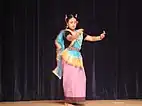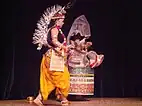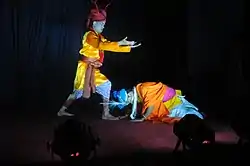Jagoi
Jagoi (Meitei: ꯖꯒꯣꯏ; Old Manipuri: ꯆꯠꯀꯣꯏ, romanized: Chatkoi) refers to the arts of dance in Meitei culture.
Different jagois (Meitei dances) of various genres of both Meitei Hindus as well as traditional Meitei religion followers (Sanamahists) | |
| Native name |
|
|---|---|
| Instrument(s) | Pena (musical instrument) |
| Origin | Kangleipak (Meitei for 'Manipur') |
General rules and guidelines
Chukpharon Jagoi
"Chukpharon Jagoi" is a Sanamahist ritual dance form performed by the maibis (priestesses) to please the lords of the four directions, Thangjing, Marjing, Wangbren, and Koubru, in the religious festival of Lai Haraoba.[2] During the performance, the maibi takes the two ekouphus (pots) from the laipubas, holding the Lainingthou ekouphu in the right hand and the Lairembi ekouphu in the left hand.[2] The dance performance portrays the dance of goddess Nongthang Leima, who saves the universe from destruction.[3]
Khamba Thoibi Jagoi
Laiching Jagoi
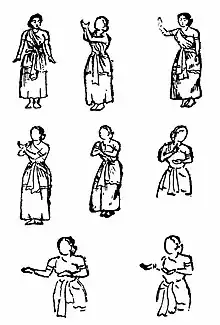
Laiching Jagoi (Meitei: ꯂꯥꯢꯆꯤꯡ ꯖꯒꯣꯢ) (literally, 'Dance of summoning the deity'[4]) is a dance form performed by the maibis (priestesses) with the langthrei (a special leaf of Blumea balsamifera) held between their fingers.[4][5] This sequence involves a variety of expressive movements where the spirit of the deity is invited to enter each maibi's body.[4] It is an invocatory dance where the maibis stand with their hands in a pose symbolizing women's union.[6] In this dance form, the maibis, after invoking the deities from water, perform leitai nongdai jagoi.[7] This dance form is performed in front of the shrine of the deities.[8]
Laihou Jagoi
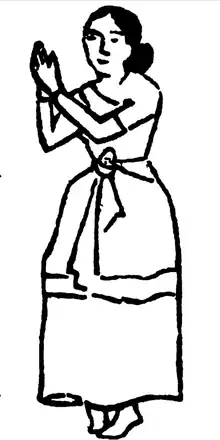
Laihou Jagoi (Meitei: ꯂꯥꯢꯍꯧ ꯖꯒꯣꯢ) (literally,'dance of invitation'[9] or "opening dance"[10]) is a dance form performed by the maibis (priestesses) to lead a way to a pond or river,[10] in the religious festival of Lai Haraoba.[11][10]
During the performance of the dance, the tune of the pena, a traditional musical instrument, is also shrimmed up.[9]
With the maibis, the sword bearing youths in two rows, the maidens with the brass vessels, the Lai bearers, the isaiphu bearers, the chong (umbrella) bearers accompany the pibas (men) holding the two pots.[11][9]
Leima Jagoi
Leisem Jagoi
Leisem Jagoi (Meitei: ꯂꯩꯁꯦꯝ ꯖꯒꯣꯢ) (literally, 'Dance of creation of the earth'[12]) is a dance form enacted by imitating the movements of nine gods and seven goddesses creating the earth, followed by Laibou Jagoi, depicting the creation of human body and various activities of man, like weaving of clothes.[13][14] The sequence of the dance is performed by the Ningol Macha (girls).[15] The six original forms of the dance are leishem, leitai, nongdai, leipekpa, leihouba and leipiba.[16] It is one of the early dance forms of Ancient Manipur contributing to the rich Manipur's classical wealth of culture.[17]
Maibi Jagoi
Panthoibi Jagoi
Panthoibi Jagoi (Meitei: ꯄꯥꯟꯊꯣꯢꯕꯤ ꯖꯒꯣꯢ) (literally, 'Panthoibi's dance' or 'Dance dedicated to the Divine Mother'[18]) is a duet dance form, portraying the romantic love affairs between Nongpok Ningthou and Panthoibi.[19][20] There are 14 hand gestures with bodily movements.[21] It is performed in the religious festival of Lai Haraoba, depicting the weaving process.[22] In the dance form, Marjing has been conflated with Nongpok Ningthou.[23] Nowadays, the dance form is replaced by the Khamba Thoibi Jagoi.[19]
Raas Jagoi
The Manipuri classical dance, also known to as the Manipuri Raas Leela dance (Meitei: Jagoi Raas/Raas Jagoi[24][25][26]), is one of the eight major Indian classical dance forms, originating from the state of Manipur.[27]
Thougal Jagoi
Thougal Jagoi (Meitei: ꯊꯧꯒꯜ ꯖꯒꯣꯢ) (literally, 'Dance of dedication'[28]) or "Jagoi Ashangbi"[29] (Meitei: ꯖꯒꯣꯢ ꯑꯁꯥꯡꯕꯤ) is a Meitei traditional dance form, performed by men and women, along with maibis (priestesses) to invoke the deities.[30] It is performed in the religious festival of Lai Haraoba.[31] The performance lasts for half an hour, after which the "Hoi Lauba" ceremony is enacted.[28]
In popular culture
- Raj Nartaki - 1941 Indian Hindi language film
- Yelhou Jagoi - 1995 non-feature Indian Meitei language documentary film
Bibliography
- Williams, Drid (2004). "In the Shadow of Hollywood Orientalism: Authentic East Indian Dancing" (PDF). Visual Anthropology. Routledge. 17 (1): 69–98. doi:10.1080/08949460490274013. S2CID 29065670.
References
- Baral, Kailash C. (2023-05-16). Cultural Forms and Practices in Northeast India. Springer Nature. p. 165. ISBN 978-981-19-9292-6.
- Lisam, Khomdan Singh (2011). Encyclopaedia Of Manipur (3 Vol.). ISBN 978-81-7835-864-2.
- Session, North East India History Association (1995). Proceedings of North East India History Association. The Association.
- Pathway.
- Doshi, Saryu (1989). Dances of Manipur: The Classical Tradition. Marg Publications. ISBN 978-81-85026-09-1.
- Narayan, Shovana (2005). Indian Classical Dance. Shubhi Publications. ISBN 978-81-8290-023-3.
- Singh, E. Ishwarjit (2005). Manipur, a Tourist Paradise. B.R. Publishing Corporation. ISBN 978-81-7646-506-9.
- Brara, N. Vijaylakshmi (1998). Politics, Society, and Cosmology in India's North East. Oxford University Press. ISBN 978-0-19-564331-2.
- Traditional Customs and Rituals of Northeast India: Arunachal Pradesh, meghalaya, Manipur, Assam. Vivekananda Kendra Institute of Culture. 2002.
- Lisam, Khomdan Singh (2011). Encyclopaedia Of Manipur (3 Vol.). ISBN 978-81-7835-864-2.
- Brara, N. Vijaylakshmi (1998). Politics, Society, and Cosmology in India's North East. Oxford University Press. ISBN 978-0-19-564331-2.
- Pratibha India. A. Sitesh. 1987.
- Rasa: Music and dance. Anamika Kala Sangam. 1995.
- Kumar, Niraj; Driem, George van; Stobdan, Phunchok (2020-11-18). Himalayan Bridge. Routledge. ISBN 978-1-000-21549-6.
- Basanta, Ningombam (2008). Modernisation, Challenge and Response: A Study of the Chakpa Community of Manipur. Akansha Publishing House. ISBN 978-81-8370-152-5.
- Meitei, Sanjenbam Yaiphaba; Chaudhuri, Sarit K.; Arunkumar, M. C. (2020-11-25). The Cultural Heritage of Manipur. Routledge. ISBN 978-1-000-29637-2.
- Ghose, Vijaya; Ramanathan, Jaya; Khandekar, Renuka N. (1992). Tirtha, the Treasury of Indian Expressions. CMC Limited. ISBN 978-81-900267-0-3.
- Chaki-Sircar, Manjusri (1984). Feminism in a Traditional Society: Women of the Manipur Valley. Shakti Books. ISBN 978-0-7069-1967-7.
- Lisam, Khomdan Singh (2011). Encyclopaedia Of Manipur (3 Vol.). ISBN 978-81-7835-864-2.
- Pathway. Marg Publications. 1988.
- Kumar, Niraj; Driem, George van; Stobdan, Phunchok (2020-11-18). Himalayan Bridge. Routledge. ISBN 978-1-000-21549-6.
- Singh, E. Bijoykumar; Singh, Ksh Jhaljit (2009). Challenges of Economic Policy in Manipur: Essays in Honour of Prof. M. Iboton Singh. Akansha Publishing House. ISBN 978-81-8370-128-0.
- Parratt, Saroj Nalini (1997). The Pleasing of the Gods: Meitei Lai Haraoba. Vikas Publishing House. ISBN 978-81-259-0416-8.
- Banerjee, Utpal Kumar (2006). Indian Performing Arts: A Mosaic. Harman Publishing House. ISBN 978-81-86622-75-9.
- Sruti. P.N. Sundaresan. 2006.
- Derek, O' Brien (2006). Knowledge Trek 7, 2/E. Pearson Education India. ISBN 978-81-7758-055-6.
- Williams 2004, pp. 83–84, the other major classical Indian dances are: Bharatanatyam, Kathak, Odissi, Kathakali, Kuchipudi, Cchau, Satriya, Yaksagana and Bhagavata Mela.
- Chaki-Sircar, Manjusri (1984). Feminism in a Traditional Society: Women of the Manipur Valley. Shakti Books. ISBN 978-0-7069-1967-7.
- Kumar, Niraj; Driem, George van; Stobdan, Phunchok (2020-11-18). Himalayan Bridge. Routledge. ISBN 978-1-000-21551-9.
- Meitei, Sanjenbam Yaiphaba; Chaudhuri, Sarit K.; Arunkumar, M. C. (2020-11-25). The Cultural Heritage of Manipur. Routledge. ISBN 978-1-000-29637-2.
- Doshi, Saryu (1989). Dances of Manipur: The Classical Tradition. Marg Publications. ISBN 978-81-85026-09-1.
